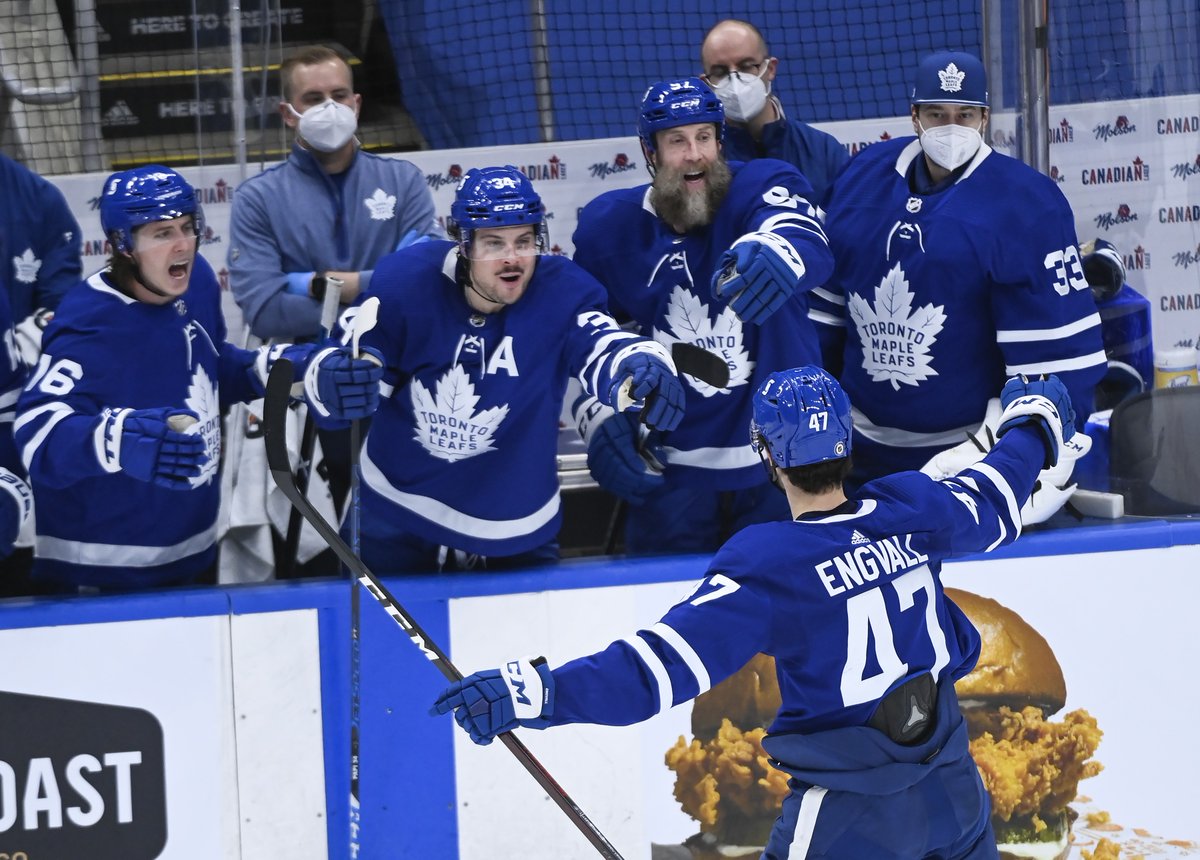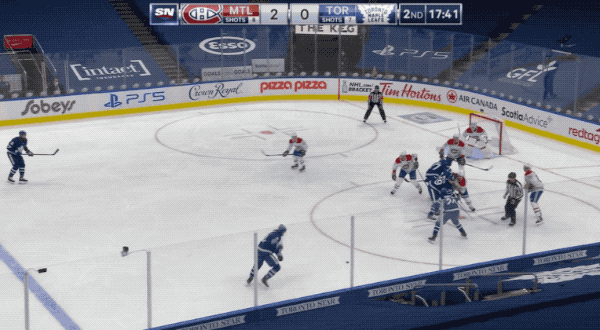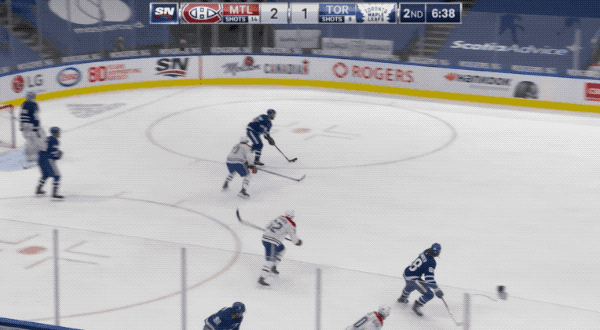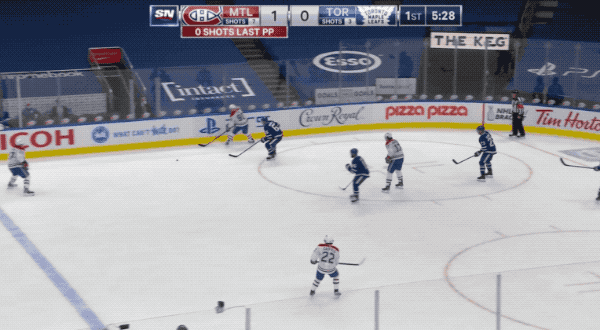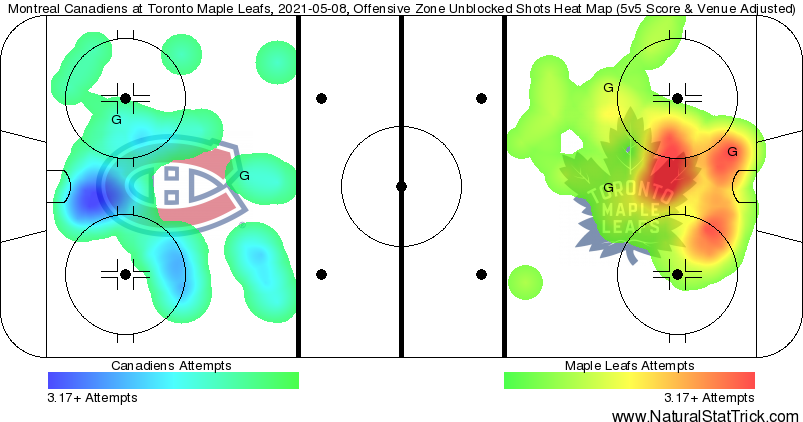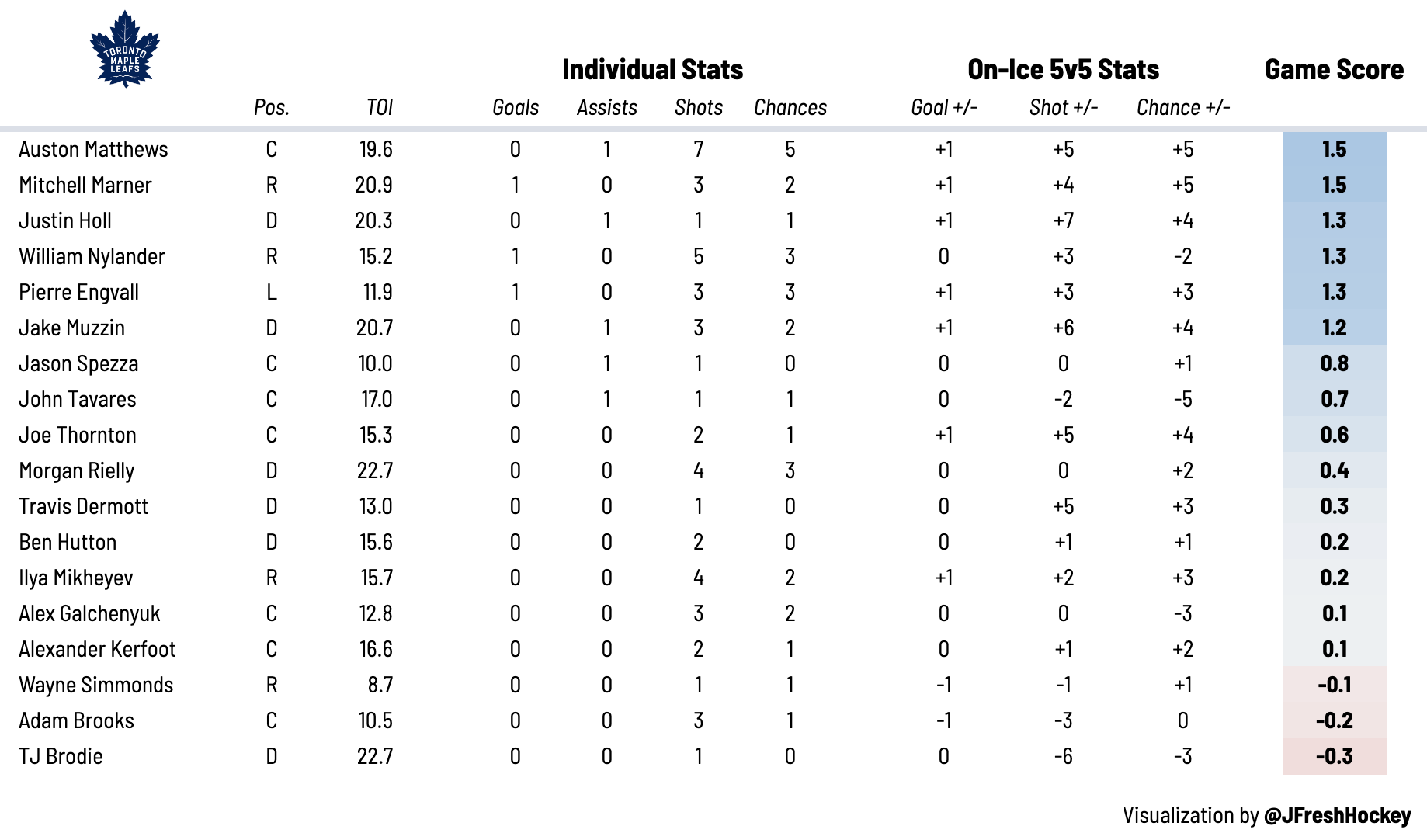The Toronto Maple Leafs didn’t appear to be too engaged to start things off in this game.
As good teams are able to do, they kicked things into gear in the second period, erasing a two-goal deficit by scoring in bunches. Toronto followed that up with a third period in which they closed the game out strong and officially secured the division title with a 3-2 win over Montreal.
This is a tough game to evaluate given the contrast between the first 25 and the final 35, but let’s go through each player individually and see if we can draw any meaningful conclusions from tonight. It’s time for some Leafs Report Cards!
5 Stars
Game Puck: Jake Muzzin (LD, #8) — I could watch Jake Muzzin PK clearances all day. He’s so good at getting himself into the right spots in the DZ that it makes life look a lot easier than it should at the level. Now, I’m not sure if his skill set is one that’s maximized on the power play — Rasmus Sandin and Morgan Rielly are much better at that — but let’s focus on Muzzin’s 5v5 and 4v5 play tonight.
As always, he was killing plays early in the neutral zone, preventing opposing forwards from crossing the blue line with possession. Muzzin also got to show off his “good stick” on the backcheck, making this highlight-reel play defensively on Cole Caufield.
Rarely do defensive plays make the highlight reels, but that was a definite turning point in the game. Most players take a penalty there, but Muzzin finds a way to go stick-on-stick and prevent the scoring chance.
If I could quickly get back to his penalty killing real quick, he did an excellent job tonight of taking away passing lanes through the middle of the ice. Sometimes he’d drop to one knee, other times he’d get his stick in the right spot. When Muzzin was able to deflect a pass, he did well to win the ensuing puck battle and clear the zone with a quick half-clapper off the boards or glass.
Again, this will come as news to no one, but Jake Muzzin is good at defense.
4 Stars
The PK Specialists — I’ve been highly critical this season of Pierre Engvall, Alex Kerfoot, and Ilya Mikheyev at 5v5. None of these players have demonstrated the ability to tilt the ice at even strength in 2021 without top-six talent — Engvall-Mikheyev without Hyman and Kerfoot without Tavares-Nylander — but you can’t deny the fact that they’re excellent penalty killers.
Engvall and Mikheyev are so disruptive with their combination of length and foot speed, putting pressure on opposing puck carriers and forcing turnovers in all three zones. This provides big-time value on defense, especially on the PK.
My biggest frustration is that neither player has been able to accomplish much of anything on offense, opting mostly for long-distance wristers from the perimeter.
Shots from 40-plus feet away aren’t going to beat NHL goaltenders clean very often, but Mikheyev and Spezza provided some chaos in front, Engvall seemed to catch Allen off guard, and the puck luck is going the big Swede’s way of late with three goals in his last three appearances.
Alex Kerfoot did a great job tonight using his speed on defense, breaking up passes, and forcing turnovers with an active stick in both the DZ and NZ. Watching him closely on the PK, he was reading the defenseman’s eyes on the breakout and taking away the pass that Jeff Petry wanted, which eventually resulted in a failed entry.
All three of these players are guys you’d love to have out there late in the third period of a playoff game when you’re killing a penalty. The issue is that none of them are NHL forwards I’d want on the ice at 5v5 in overtime, at least if I’m a legitimate cup contender.
It’ll be interesting to see who makes the cut when everyone’s healthy.
William Nylander (RW, #88) — There’s a reason getting the puck over the blue line with possession has value. Most goals are scored within 10 seconds of gaining the zone, which is why a player like Nylander has so much value against tight-checking teams in the neutral zone.
A lot of forwards dump the puck in here. Not Nylander — he refuses to punt on the possession, which pays dividends a few seconds later. He made a lot of plays like these tonight, using his speed to move play up the ice and into the offensive zone with control.
Defensively, one of the biggest things I’ve noticed lately is his knack for batting pucks out of mid-air to regain possession. It’s most noticeable in the neutral zone, where he’ll often intercept saucer passes and create a rush opportunity the other way for Toronto. Nylander did get a bit too aggressive with his stick in the third period, but you can live with that considering how “engaged” he looked later in the game, much like the rest of his teammates.
Mitch Marner (RW, #16) — It was a pretty listless period and a half for Marner to start things off — again, much like the rest of his team — but he found a way to get things going offensively as the game went on. Catching a puck on its side after an OZ faceoff win, he rifled a wrist shot past Jake Allen.
After that, you could really see his creatives juices starting to flow at 5v5. He was kicking the puck to himself to get around defenders, even back-heeling a soccer pass to Matthews after his stick got shattered off of a blocked shot. In the offensive zone, Marner was making crafty moves to beat defenders 1v1 on the cycle, opening up passing lanes to his teammates.
The cherry on top was his defense to close out the game, with tight checking in the neutral zone and quick clearances out of the defensive zone when Montreal had their goalie pulled. It’s been fun to watch his development into a 200-foot player over the last few seasons. He’s become a player you want on the ice in key situations, whether you have the lead or you’re playing from behind.
Ben Hutton (LD, #55) — There are a lot of smart Canucks fans who will tell you good things about Ben Hutton. We saw some of them tonight: gapping up in the neutral zone, making surprisingly decent plays with the puck out of the defensive zone, and some physicality.
His big hit on Josh Anderson was a nice momentum swing for the Leafs, especially considering Wayne Simmonds got knocked down by the Canadiens’ power forward earlier in the game. How much does this “grit” stuff really matter? I’d like to tell you it’s overrated, but everyone who works in professional hockey seems to think it has value heading into the playoffs, so who am I challenge the groupthink here?
3 Stars
Coaching Staff — Special teams is where a coaching staff can make a massive difference.
Things look great on the penalty kill lately, with the Leafs forming a “wedge + 1” in their own end, creating a triangle of three players to cover the slot while one forward pressures the puck on the perimeter. The Leafs did a great job opportunistically applying that pressure at the right time, forcing turnovers and clearing the zone. I also really liked the way they gapped up on entries at the blue line.
Things…don’t look so great on the power play. You could argue Toronto doesn’t want to show their first-round opponent their Master Plan before the games start to matter, but gaining the zone sure would be nice. Here’s hoping we see some quicker, less predictable puck-movement at 5v4 in the near future.
Jack Campbell (G, #36) — After letting in an absolute stinker from Nick Suzuki off the rush, Campbell was able to regain his composure and shut things down in the third when Toronto was protecting a one-goal lead. There were a few more quality chances towards the end of the game than you’d like to see if you’re a Leafs fan, but Campbell managed to fight everything off, while showing some solid rebound control to prevent any more chaos.
Auston Matthews (C, #34) — How crazy is it that he can lead the team in shots, chances, points, 5v5 scoring chance and goal differential, yet I still think he could’ve played better?
Maybe these are just the unrealistic standards to which we’ve come to hold Auston Matthews, feeling almost cheated when he goes one night without finding the back of the net. I’m not arguing he played poorly, more so that we’ve seen him dominate games at 5v5 for the majority of the season, whereas tonight’s game felt merely “good” for the most part.
“Good” is enough for most NHL players, but Matthews has solidified himself as a top three NHL player this season. We’ve come to expect “great” things from him most nights.
Morgan Rielly (LD, #44) — This was a tough one for me to evaluate. The pairing didn’t show too well by the underlying numbers in their shared 5v5 ice time, but I found myself typing mostly positive jot notes next to #44 on his shifts. “Lots of clean zone entries…solid 2v1 defense…creating offense by activating down the left wall and looking for high-value passes” – I didn’t have many criticisms of his play tonight.
One thing that stuck out to me is his tendency to hold his stick in the air in the defensive zone, which is a bad habit you’d like to see worked out of his game — you can’t get your stick on passes if it isn’t on the ice. For the most part, though, I’d argue his strong offensive play outweighed any defensive concerns.
Joe Thornton (LW, #97) — Before Marner started to heat up, Thornton was actually the one doing most of the passing on the top line. He was recovering loose pucks in the offensive zone, an area where he’s always been elite, and making the “next pass” on the cycle to keep his team in possession.
As Marner and Matthews started to heat up, Thornton took more of a backseat offensively, although it’s worth pointing out his defensive positioning was quite strong. Despite his lack of foot speed, he’s always done a great job of “staying above” his man defensively, which helps prevent odd-man rushes.
Justin Holl (RD, #3) — The good news is that Holl looked great on puck retrievals tonight, helping his team start the breakout instead of spending 40 seconds stuck in their own end. This was also true on the penalty kill.
The bad news is that he picked up a tripping penalty on a whiffed poke check and had his controller unplugged on the following 2v1 rush.
I should have known something would go wrong when I saw Mikheyev in a 2v1 situation. This is more of a blooper than anything, but if we take a step back and think of things at the macro level, Holl hasn’t been as impactful in the offensive zone lately. One of his standout traits as a player is his ability to jump up and make a smart play in the offensive zone when needed.
2 Stars
John Tavares (C, #91) and Alex Galchenyuk (LW, #12) — I like that Galchenyuk is throwing his weight around in puck battles. His energy level on the defensive side of the puck was much more in line with those first few games he played in a Leafs jersey. The numbers will show that this is his “least bad” defensive season in the last six years, while the offensive value he’s providing has made him a net positive at even strength.
On the flip side of things, he was responsible, once again, for an odd-man rush that resulted in a goal against. Campbell needs to make that save on Suzuki, but the play wouldn’t have happened if Galchenyuk stayed above his man as the third forward (F3) in the offensive zone. Sometimes the most important defense happens 200 feet away from your net.
If I’m going to criticize Galchenyuk for blowing assignments, it’s only fair I point out Tavares was also late getting back a few times as F3 as well.
Travis Dermott (RD, #23) — I don’t want to waste time telling you Dermott played a tight gap tonight, so let’s talk about his offense. My biggest disappointment in his development has been his lack of dynamic play in the offensive zone. He’s great in transition, both with the puck and without it, but against a five-man cycle defense, Dermott can’t seem to get his shot through traffic.
The Brooks-Spezza Pair — As meaningless as these last few games are, tonight was another opportunity for Adam Brooks to prove he belonged in Toronto’s top 12 heading into the playoffs. Unfortunately, it wasn’t his best night. He and Jason Spezza weren’t quite able to pull off the passing sequences we’ve seen in games past.
I did like a few of Brooks’ passes in the neutral zone to reverse play to the opposite side of the ice, but for the most part, he didn’t have a major impact on the outcome of the game tonight.
TJ Brodie (RD, #78) — As much as I’d like to discuss the odd slip pass or OZ keep that Brodie made to impact play in a positive direction, the results weren’t great tonight: Toronto got outshot by six and out-chanced by three when Brodie was on the ice at 5v5.
Wayne Simmonds (LW, #24) — Maybe I’m not evaluating Wayne Simmonds the same way most fans and analysts are this season. I’ll scroll through my Twitter timeline and see positive mentions of his physicality and energy on the forecheck. I’ll listen to the broadcast and hear his coaches and teammates praise Simmonds for what he’s meant to this Leafs team effort.
Then I’ll watch his shifts and see him constantly turn the puck over at 5v5 in the neutral zone. I want Simmonds to succeed, but the objective analyst in me just isn’t seeing it. A few games ago, I made a list of Toronto’s top 12 forwards, placing Simmonds in there since I expect him to be in their playoff lineup.
Realistically, though, is he one of Toronto’s 12 best forwards when everyone’s healthy? I want him to be, but I just can’t get there.
Heat Map
Here’s a quick look at where each team’s shots were coming from at even strength, courtesy of Natural Stat Trick.
The shots and chances were closer than you think at 5v5. Toronto “only” controlled 51 and 52 percent of those respectively but generated 62 percent of the expected goals. Go figure!
Game Score
Game score is a metric developed by The Athletic’s Dom Luszczyszyn to measure single-game performance. You can read more about it here.
Tweets of the Night
Good time to revisit this one. The art of shooting the rolling puck. Marner does it perfectly for the go ahead goal. pic.twitter.com/WQu8P1ETMa https://t.co/Dk8nPGO7wU
— Mike Johnson (@mike_p_johnson) May 9, 2021
For my money, the best hockey analysis is the kind that makes you think. This is a great example from Mike Johnson, breaking down how a rolling puck can actually throw off the goaltender’s ability to read the shot coming off the player’s stick.
🎯👏💯
🎥 @Sportsnet pic.twitter.com/r6E7klAt5J— Here's Your Replay ⬇️ (@HeresYourReplay) May 9, 2021
“You never played the game” is what I’m often told whenever I bring up this side of the argument. I love hockey more than anything, but I’d also like to feel better about putting my future children in the sport.
Knowing what we know about concussions, early onset dementia, and CTE, why would I put someone I love in danger knowing the NHL and Department of Player Safety don’t give a damn about their long-term health?
Beat cancer at age 19
First NHL rookie to be awarded the Bill Masterton Memorial Trophy
2 cup rings
2010 Olympic silver medalist
2014 Olympic top forward
One of 25 players to have over 500 consecutive games played
900 NHL points and counting https://t.co/Z0kWCg9C0Y
— Arjun (@_marlanderthews) May 8, 2021
A lot of Leafs fans can’t stand the guy, but I remain a Phil Kessel die-hard. I’ll never forget the fact that he ranked third in the NHL in points from 2011-14, and also that the Leafs are still eating $1.2 million of his salary per season until 2022.
























